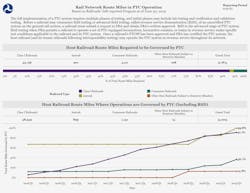FRA says railroads making “steady progress” in Q2 2019 PTC update
The Federal Railroad Administration (FRA) provided a quarterly status update on railroads’ progress in fully implementing positive train control (PTC) systems. Based on railroads’ Second Quarter 2019 PTC Progress Reports which were due to FRA by July 31, 2019, the 42 railroads subject to the statutory PTC mandate are making steady progress.
“FRA is determined to help all affected railroads successfully satisfy the statutory deadline for full PTC system installation, testing, certification and ultimately initiate operations governed by PTC on all required territories,” said FRA Administrator Ronald L. Batory. “FRA is currently directing its focus and resources on the technical challenges facing the railroads, including commencing revenue service demonstration, interoperability testing and safety plans.”
As of June 30, 2019, PTC systems were in operation on approximately 50,300 (87 percent) of the nearly 58,000 route miles required to be equipped by Congress. This reflects a four-percent increase since Quarter 1 of 2019. Nonetheless, railroads must still complete significant work to fully implement their PTC systems by Dec. 31, 2020, especially with respect to activating PTC systems on the remaining required main lines and achieving the necessary interoperability with their tenant railroads.
Specifically, host commuter railroads report that as of June 2019, they were operating their PTC systems in revenue service demonstration (RSD), a type of required advanced field testing, on approximately 698 route miles and in revenue service on 443 route miles, which, in total, is 37 percent of the host commuter railroads’ 3,111 required route miles and a 12-percent increase since Quarter 1 of 2019.
Class 1 freight railroads report that PTC systems are in operation on approximately 91 percent of their required main lines as of June 2019—representing a four-percent increase since Quarter 1. As a host railroad, Amtrak reports that approximately 899 of Amtrak’s 901 (99.8 percent) required route miles are governed by a PTC system. In addition, Amtrak informed FRA that its operations are currently governed by a PTC system on at least 16,032 of the 19,119 route miles (84 percent) where Amtrak operates as a tenant railroad on other railroads’ PTC-equipped main lines.
All railroads have committed to fully implementing PTC systems on the required main lines by Dec. 31, 2020, if not earlier. Nonetheless, Administrator Batory and senior FRA officials continue to host meetings with dozens of individual railroads and groups of railroads, vendors, suppliers, and subject matter experts to actively monitor developments and identify potential solutions where challenges arise. In addition, regular meetings are being held with the executive leadership of Amtrak and each commuter railroad that operates on or near Amtrak’s Northeast Corridor and/or the commuter railroad’s own PTC-mandated main lines in the Northeast.
Finally, FRA will host the remaining four of six PTC Collaboration Sessions over the next 16 months to further support all railroads subject to the statutory mandate and to convene the industry’s technical experts to share best practices and jointly resolve common technical problems.
Since 2008, through FRA, the department has awarded nearly $2.6 billion in grant funding and loan financing to support railroads’ implementation of PTC systems, which amounts to nearly 18 percent of the industry’s estimates for initial PTC system implementation costs.
